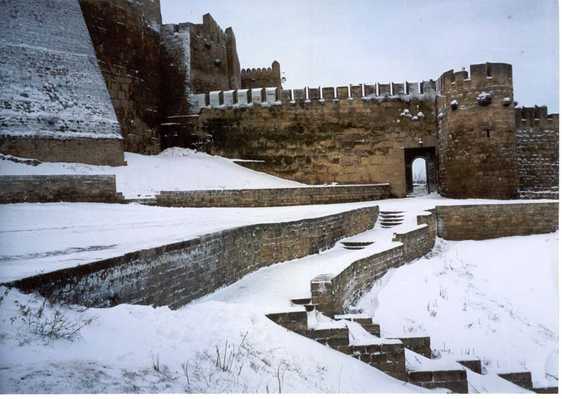The article below “Fortifications” by Wolfram Kleiss in the Encyclopedia Iranica was originally published on December 15, 1999 and last Updated on January 31, 2012. Kleiss provides an overview of the fortified passages and defenses of the Sassanians, some of which can be traced back to the Achaemenid era.
This article is available in the print volumes of the Encyclopedia Iranica (Vol. X, Fasc. 1, pp. 102-106).
Kindly note that the article below contains pictures and captions that do not appear in the Encyclopedia Iranica version.
==============================
The present article deals with the fortified passages and defenses that are implied under the term bārū. Certain passes in Persia still feature barriers going back to the Achaemenid period. An example is the stone wall at the Kotal-e Sangar in Fārs, which bars the way from Persepolis and Bīšāpūr to Ḵūzestān on the saddle (not a real pass) between the Mamassanī plain (plain of Deh-e Now) and the Fahlīān plain, and which is identical with the medieval and modern caravan route (today’s modern highway between Shiraz and Ahvāz). The rubble wall that by now has almost entirely disappeared was originally 1,230 m long and extended between both sides of the saddle’s rugged, steeply rising rock faces. The construction has been associated with a wall mentioned by Arrian (Anabasis 3.17), which the Uxians are said to have erected as a customs-barrier on the road between Ḵūzestān and Fārs, and around which Alexander had made a great détour on his expedition from Susa to Persepolis before taking it by surprise (Stein, pp. 39-44; Kleiss, p. 213, fig. 1).
Another wall (Kleiss, p. 214, Fig. 2) was built on top of the pass 36 km east of Farrāšband and 28 km west of the modern city of Fīrūzābād in the province of Fārs. It overlooks the road between the Sasanian settlements around Farrāšband and the Sasanian round city of Gōr (q.v.) with the bridge over the river west of Fīrūzābād, and is, at the same time, a barrier similar to the one in the Qalʿa-ye Doḵtar area north of Gōr (present-day Fīrūzābād, q.v.), a fortification at the northern access to the plain of Fīrūzābād (Huff). The barrier on the pass extends over a length of about 200 m in a fairly straight line from northwest to southeast in the shape of a ruined rubble wall that was once of considerable height. On the eastern side of the wall lies a heap of stones, the remains of a small halting-place or a tower, the exact measures of which are unknown. The dating of the barrier is unclear; perhaps it was built in the Sasanian period and continued being used in the Islamic period.
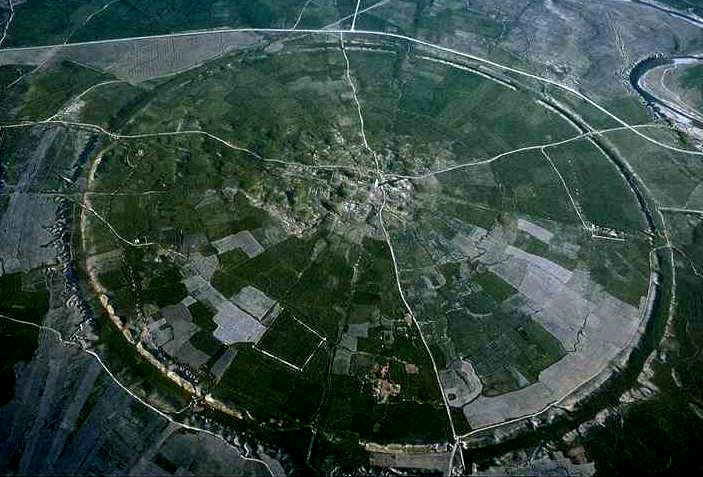 The Sassanian City of Firuzabad, known as Gur or Ardashīr-Xhwarra (located in Fars province, approx. 110 km south of Shiraz) (Source: CAIS). Gur is built as a perfect circle measuring at 1,950 meters in diameter and partitioned into 20 sections. The city was surrounded by a primary wall constructed of stamped clay, a ditch measuring at 35 meters width, as well as an inner-wall of defense.
The Sassanian City of Firuzabad, known as Gur or Ardashīr-Xhwarra (located in Fars province, approx. 110 km south of Shiraz) (Source: CAIS). Gur is built as a perfect circle measuring at 1,950 meters in diameter and partitioned into 20 sections. The city was surrounded by a primary wall constructed of stamped clay, a ditch measuring at 35 meters width, as well as an inner-wall of defense.
Roads over passes were rendered defensible without any specific effort at fortification, but only through the itinerary and the constructive protection of the pass, an example being the Kotal-e Doḵtar on the caravan road from Shiraz via Kāzerūn to Būšehr (Figure 3). The way up to this pass from the Kāzerūn plain could be blocked at any time at its serpentine curves and defended by means of traditional weapons (Nathusius, p. 160).
The most important fortification in Persia is the mud-brick wall mistakenly called Alexander’s Wall (Sadd-e Eskandar), which shields the fertile foot-hills leading to the plain of Gorgān against the Turkman steppes. This structure consists of a mud-brick wall stretching out like an embankment, and, adjacent to the wall, 33 forts of varying forms and sizes (120 x 120 m to 300 x 200 m) placed at different distances from one another (400 to 9,850 m). The Gorgān wall (Kiani) was built in the Parthian and Sasanian period as a rampart against attackers, and this function makes it comparable with the Roman limes, constructions in England and Germany, and with the Great Wall of China. The Turkmans call the wall Qïzïl Alan, and in Persian it is also called Sadd-e Pīrūz and Sadd-e Anūšīravān. The Gorgān wall is 175 km long, extending from the Caspian Sea to the Alborz and the north-eastern mountain chains of Persia. The remains of the wall end in the west, north of Gomīšān, at a distance of about 5 km from the Caspian Sea coast, which is due to the variation in the level of the Caspian (now 27 m under sea level) and the very flat level of the coastline. As far as is known, the eastern end of the wall joins the mountain-range at Piškamar, 58 km northeast of Gonbad-e Qābūs, its further prolongation to the east being questionable. The wall is at present 2 to 5 m high and about 10 m wide. A ditch 3 m deep and up to 30 m wide runs along the outer side of sections of the wall. The wall itself is constructed of unbaked bricks (50 x 50 x 10 cm) and baked bricks (40 x 40 x 10 cm). Excavations along the wall and in the forts belonging to it have produced Parthian gray ceramics, Parthian red ware, and glazed Islamic pottery.
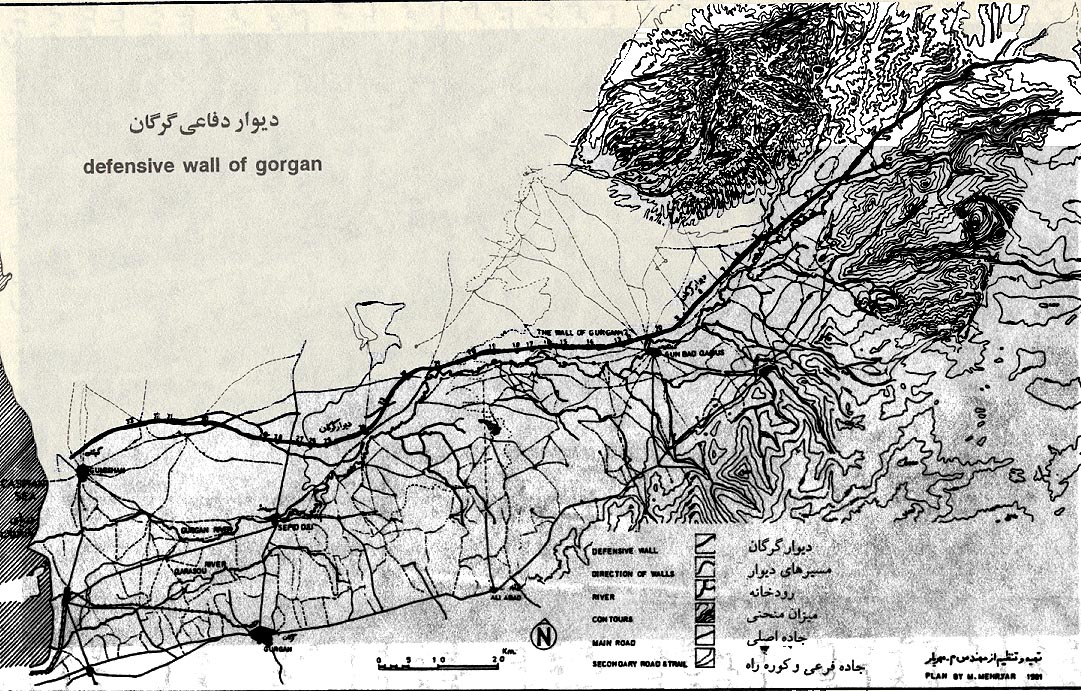 An Iranian map of the Gorgan wall. The works of Dr. Kiani in 1971 were invaluable in helping lay the basis of mapping the structure. The Gorgan Wall is second only to the Great Wall of China in length. For more on this topic see: Farrokh, K. (2010). The Great Wall of Gorgan: One of the World’s Greatest Frontier Walls. Tehran Times International Daily, March 9, p.7.
An Iranian map of the Gorgan wall. The works of Dr. Kiani in 1971 were invaluable in helping lay the basis of mapping the structure. The Gorgan Wall is second only to the Great Wall of China in length. For more on this topic see: Farrokh, K. (2010). The Great Wall of Gorgan: One of the World’s Greatest Frontier Walls. Tehran Times International Daily, March 9, p.7.
The Gorgān plain is protected by two fortifications on its western border, at the narrowest part of the flat plain between the mountains and the Gorgān Gulf (Ḵalīj-e Gorgān), east and west of Bandar-e Gaz and south-east of the Caspian Sea. Extending between the foot-hills of the Alborz mountains and the Ḵalīj-e Gorgān coast, the defensive barrier, approximately 11 km long, is now barely recognizable as a very overgrown earth wall with a height of 1 to 3 m and a width of 2 to 2.50 m. The barrier begins near the ruined city of Tammīša (Ṭamīsa/Ṭamīs in Ar. sources) at the foot of the mountains. A further fortified wall running parallel to it is found 22 km to the west, between Bandar-e Gaz and Behšahr (qq.v.; Kleiss, pp. 215-16). The ruins of Tammīša, near the village of Sar Kalāta, prove to be of Sasanian to Saljuq origin (6th to 9th cents.), which is probably also true of both walls (Bivar and Fehérvári). The fortified wall near the ruined city of Tammīša at the foot of the Alborz mountains is built of clay and baked brick (36 x 36 x 10 cm). Excavations at the wall and in the Tammīša area produced glazed and unglazed Islamic pottery of the 9th to 15th centuries. In their strategic function, the walls of Tammīša correspond with the fortifications of Darband (q.v.; Turk: Derbent) in Daghestan on the western coast of the Caspian Sea (Bretanizkiĭ, p. 375, fig. 214; Ebn Bakrān, pp. 81-82). The latter, with their approximately 150 km long wall ascending the Caucasus heights, were to protect the Persian frontier against the tribes of the northern steppes. This construction is also mistakenly called Sadd-e Eskandar, but building details clearly show that the walls are of Sasanian origin and point to a comparison with the structure of the Taḵt-e Solaymān wall in Azerbaijan (Naumann, p. 35, fig. 15). The Darband fortification, which consists of five sections, is about 2,250 m long, from the coast to the western corner of the citadel (arg), and has an interior dimension of 240 to 250 m for the city area. The northern wall features a closer disposition of the towers than the southern wall. Four gates each face north and south, respectively, and the individual sections of the city are connected by additional gates.
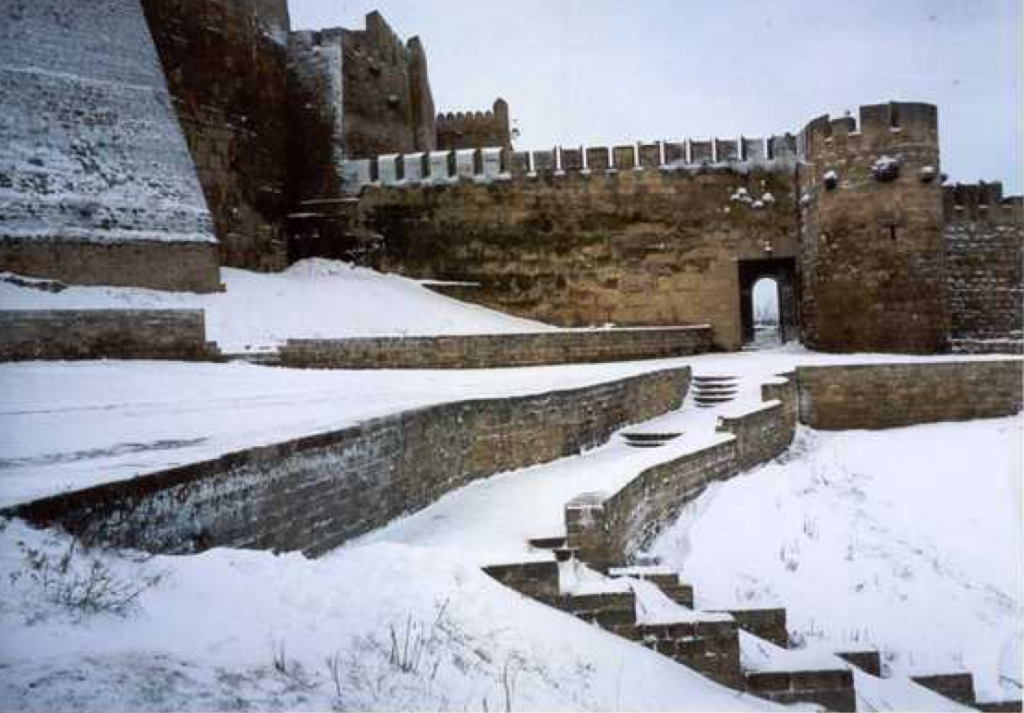 The Wall of Derbent (also known as Krevar to locals) in Daghestan as it appears in winter. This is an enduring testament to Sassanian military engineering in the Caucasus (Source: Public Domain).
The Wall of Derbent (also known as Krevar to locals) in Daghestan as it appears in winter. This is an enduring testament to Sassanian military engineering in the Caucasus (Source: Public Domain).
In its structure as a fortified barrier for the control of a coastline, Darband can be compared with the entire complex of the Byzantine-Turkish fortifications of Trabzon/Trebizond. Between the Black Sea and the Pontus mountains, it attains a length of about 900 m and is divided into three parts: the lower city (Aşağı Hisar), the central city (Orta Hisar), and the citadel (İç Kale; Sinclair, II, p. 48).
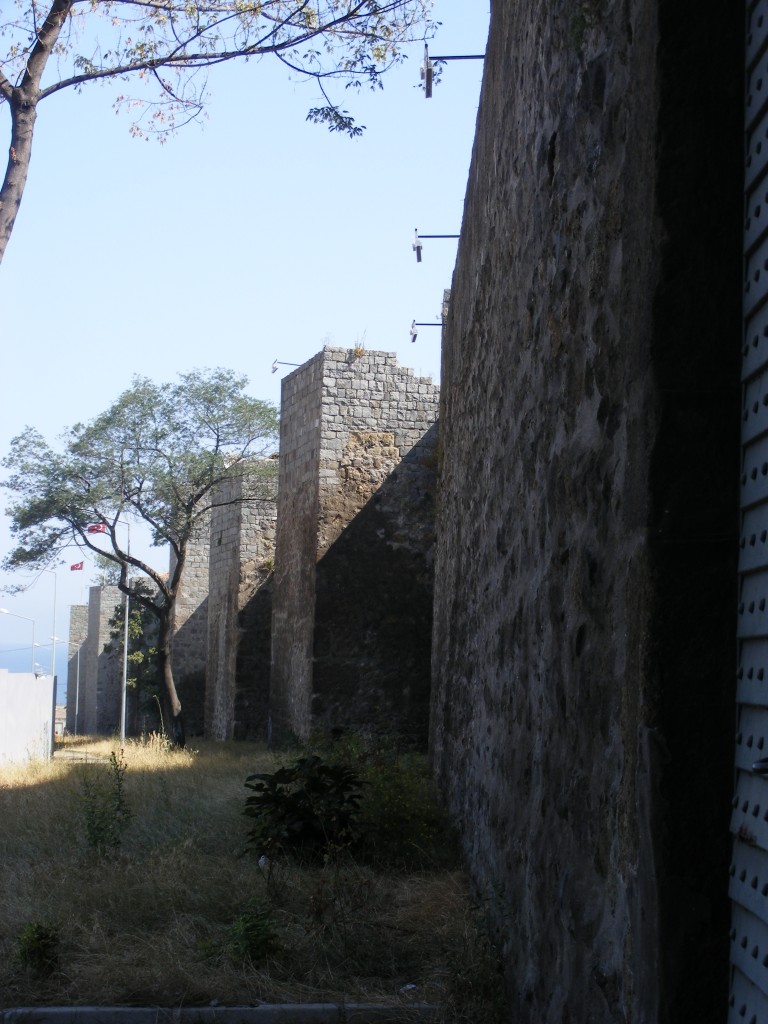 The Byzantine-Turkish defense walls at Trabzon (Source: Public Domain).
The Byzantine-Turkish defense walls at Trabzon (Source: Public Domain).
The position of the citadel of a fortified settlement in the center of the circumvallation is rare. An original example is the Sasanian to early Islamic citadel on the conical rock in the center of the round city of Dārābgerd (Figure 7). In Isfahan and Shiraz the citadels lie within the walled city; they do not connect with the city wall and have no direct connection with the environment outside the city wall (Figure 8).
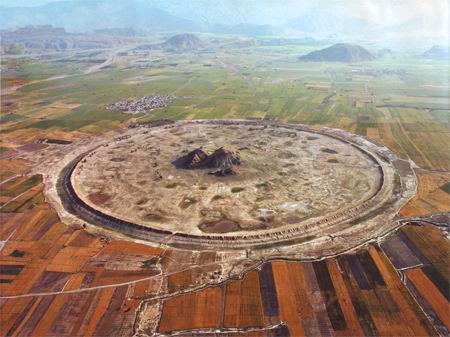 The round city of Darabgerd (Source: CAIS).
The round city of Darabgerd (Source: CAIS).
The citadels belonging to fortified settlements are usually built on sites offering the most suitable terrain for fortifications. As a rule, they are built on heights within the area of the settlement. Most citadels are situated at the edge of the settlements, are structurally connected with the city walls and have gates leading both to the city and to the open country—as is the case with Herat, Bam, Kars, Van, Dāmḡān, or the old town of Tehran. The last wall built around Tehran in the 19th century surrounded the citadel (the Golestān Palace complex) as the center of the walled city.
Bibliography
A. D. H. Bivar and G. Fehérvári, “ The Walls of Tammisha,” Iran 4, 1966, pp. 35-50.
L. S. Bretanitskiĭ, Zodchestvo Azerbaidzhana XII-XV vv. i ego mesto v arkhitekture Perednego Vostoka Moscow, 1966.
Moḥammad Ebn Najīb Bakrān, Jahān-nāma, ed. M.-A. Rīāḥī, Tehran, 1342 Š./1963.
D. Huff, “Ausgrabungen auf Qaleh Dukhtar,” in AMI, N.S. 9, 1976, pp. 157-73.
M. Y. Kiani, Parthian Sites in Hyrcania: The Gurgan Plain, AMI, suppl. vol. 9, Berlin, 1982.
W. Kleiss, “Sperrbefestigungen in Iran und Vergleiche zu europäischen Beispielen,” Archäologische Mitteilungen aus Iran und Turan 30, 1998, pp. 213-14.
A. Nathusius, Im Auto durch Persien, Dresden, 1926.
R. Naumann, Die Ruinen von Tacht-e Suleiman und Zendan-e Suleiman, Führer zu archäologischen Plätzen in Iran 2, Berlin, 1977.
T. A. Sinclair, Eastern Turkey: An Architectural and Archaeological Survey, 4 vols., London, 1987-90.
A. Stein, Old Routes of Western Iran, New York, 1940.

